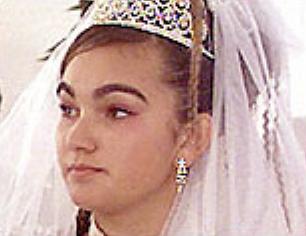| ||||||||


|
12-year-old
Child Bride Akira Kato
September 30, 2003
This is a story about a 12-year-old girl, Ana Maria, who lives in Sibiu, Romania. All she wanted was to stay in school and to have fun with her friends. So when the Roma gypsy princess found herself being married off to a 15-year-old boy, she lifted the hem of her vast 4,000-euro wedding dress and fled the church as guests sang cheerful marriage songs around her. The groom Birita Mihai looked stunned but his child bride’s revolt was shortlived. Her father, Romanian Roma king Florin Cioaba, had her brought back and she was promptly married against her will. Cioaba, whose authority is being challenged by a rival king, invited hundreds of guests to a three-day wedding party for which 12 pigs were slaughtered and 4,000 bottles of wine served. The bride’s friends rallied for Ana Maria, chanting “Down with Birita.” Her father was obviously embarrassed by her revolt but unmoved by their pleas or her tears. Later that night, the groom’s family proudly showed the wedding guests a bloodied bedsheet to prove the marriage had been consummated. For girls in Romania the legal age of sexual consent is 15, and for marriage 16. “Legally it was rape,” a friend of the bride’s said.
How come nobody interrupted this thing? Among Romania’s Roma, estimated to number between half a million and three million, child marriages are common and authorities have traditionally turned a blind eye. Police directed traffic outside Ana Maria’s wedding and took no action to prevent it. The Romanian government would not comment on the incident. But as the ex-communist country prepares to join the European Union as early as 2007, things may have to change.
What will happen to Ana Maria?
She will leave school and concentrate on her job as a wife. And she will also help her mother-in-law cook and clean and raise her children. It doesn’t matter what she wants. Roma minority officials defended the child marriage. “The princess’s marriage was not set up by force. She is as precious to the king as his own eyes. He wouldn’t have done something against her will,” said an official of the Roma Center for public policies. Many Roma people think that they must keep their traditions alive to keep their identity intact and to survive. And they believe that no one has the right to forbid their customs. However, EU officials insist that “Implementation of human rights for everyone is essential for full entry into the European Union”.
The whole thing sounds outrageous, but . . . When I heard of this story for the first time, I thought, “Oh, another story from India, eh?” So, the story didn’t really surprise me at all. When I read it in detail, however, the whole thing stunned me because it happened in Europe—a supposedly well-advanced political and historical block. Naturally, the story piqued my interest to a super-duper degree and let me click through many Web pages, and I said, “Oh my god, this is rather a profoundly deep-rooted problem!” Indeed, the above child marriage seems only a tiny tip of the iceberg! And I’ve realized that I can’t make a hasty conclusion on this issue. Many “Roma” people think that they must keep their traditions alive to keep their identity intact and to survive. And they believe that no one has the right to forbid their customs. I now understand how come they believe the way they do.
The “Roma” people have gone through the harsh reality just as the Jews have. Here is a brief history of the problems that the “Roma” people have gone through. In Europe, nationalist ideologies began to take hold in the 18th century as a reaction to the conflict between the church and dynastic monarchy. As you know, this conflict brought the middle classes and different ethnic communities into the arena of political life. For the first time, languages and cultures, majorities and minorities, became the subject of public debate. Nationalism in Romania was born in the late 19th century, fuelled by the war of independence in 1877. In a process of decolonization, the Romanian nation-state began to define itself after its emergence from the rubble of the Ottoman Empire by adopting the western European political and economic system. The 1848 reform generation sought a speedy integration into the European pattern. However, the result appeared ill-adapted to local realities. The new Romanian elite of 1877 tried to establish a “Romanian model” by softening social change and making people from lower levels of society feel closer to the newly-created national cause. They wanted to provide them with both a common perception of their country and a shared sense of identity. The Romanian elite chose to offer its people the simplest and most conventional model of nationalism. They practically meant, “If you do as we do, you develop culture. If not, you belong to a subculture.” Xenophobia and racism naturally followed. The most important Romanian national writers of those times and even later were also the harshest anti-Semites. In 1856, the slavery was abolished.
The Roma had been slaves in Romania for more than 500 years. Having the status of a slave meant that Roma were not perceived as members of the human race. They were objects of exchange, sometimes sold by weight: a Rom could be sold for a smaller price than two copper pots, a Roma child could be bought for a smaller price than a cow, because she was not yet good capable of working full-time. Indeed, a Romanian word tsigan for Roma meant “slave” in the language of those times. Masters offered Roma girls as pleasure toys to their guests. Marriages between Roma and Romanians were strictly forbidden by law. Roma and Romanian graveyards were also separate. Roma slave settlements were outside villages, their inhabitants isolated and barely scraping together a living, with no access to any institutional education or social support. This was a natural fact for a non-person or slave. Romanian slavery was an apartheid system. Racism continued well after the abolition of slavery. Liberated from it, Roma were simply evicted from their masters’ lands and their huts, with no means of survival, and no resources to carry on with their lives. Many of them went back to their former masters, begging for food and shelter in exchange for hard work: doing anything to survive. That way, they continued to be half-slaves, servants in the masters’ houses or working on the land, with no access to development resources or to school education. In a gradual, step-by-step process, Roma began to lose their cultural identity and internalize their inferior status in society as if it were inalienable. Ashamed of themselves, they were stigmatized and excluded from the society of their former masters. Roma thus became a scapegoat for all the frustrations and failures of the Romanian society.
The problem after the abolition of slavery Even after the abolition of slavery the political leadership of Romania agonized over whether or not to grant Romanian citizenship to Roma. The latter were in fact considered strangers in their own country. Between the two world wars, many prominent Romanian intellectuals declared that the Constitution of 1927, which indeed gave citizenship to Roma, Jews and Turks, was against the spirit of the Romanian nation-state. During the second world war, Romania’s alliance with Nazi Germany was no political gesture. It was based on the rise of far-right ideologies, promoted by the most important representatives of the Romanian cultural elite. These ideologies emphasized the need for a nation-state to be formed by “one single race”, to fight any attempt to mingle nations or erase borders, and to eliminate any person that thought or acted differently. Paramilitary organisations such as the “Iron Guard” were also established and they carried out killings. Politicians of the moderate right, left-wing intellectuals, Roma and Jews were the victims. During the military dictatorship of Marshal Antonescu, one of Hitler’s allies, the far-right ideologies of the legionary movement became state policy. One of its missions was to eradicate “the Gypsy plague”. The Holocaust against Jews and the genocide against Roma began. Roma were deported to Transdniestria and killed. Official figures speak of more than 36,000 Roma who died there, amongst whom there were more than 6,000 children.
The problem after the communist regime After centuries of institutional racial discrimination, the Romanian government policies towards Roma today appear “politically correct”. These are influenced by Romania’s aspiration to become a member of the European Union. Roma are recognized as a national minority and the Romanian government has adopted a national strategy to improve their social situation. Despite this, some say that the government allocates no financial support for its strategy, and that there is no real political will to put it into practice. Other say that local authorities act in an openly discriminatory way against Roma, ignoring the strategy and confining Roma to special ghetto neighbourhoods or forcefully evicting them from their settlements. Some media reports claim the following problems:
Although I haven’t verified the above facts, I consider these findings reasonably accurate, taking into consideration the historical events and the situation of the current “Roma” people. Underneath the child bride lie a variety of fundamental problems of the “Roma” people. I can’t tell whether or not child marriage is right or wrong at the moment. However, I can tell, at least, that everybody should listen to what the minority want to tell the world about this supposedly anti-humane marriage.
| |||||||
|
| ||
|
|
Everything on 007 James Bond from Amazon.com |
| Beaverland Forum |
| Featuring thought-provoking columns and stories |

















 Ana Maria moved to the groom’s house soon after the wedding in the
medieval Transylvanian city of Sibiu.
Ana Maria moved to the groom’s house soon after the wedding in the
medieval Transylvanian city of Sibiu.
 Interesting Links
Interesting Links